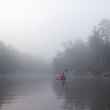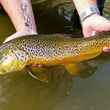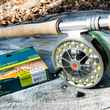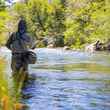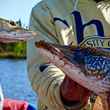The Truckee River drains from Lake Tahoe on California’s wooded border toward Pyramid Lake in Northern Nevada’s desert basin. Pyramid Lake, where the Truckee crouches to its end, is a remnant of the prehistoric behemoth Lake Lahontan that, some nine thousand years ago, had most of Nevada under nine hundred feet of icy water. The Truckee River is what keeps the Pyramid Lake basin from turning into Black Rock Desert and breathes continual life into petrified Ichthyosaur skeletons the beachside petroglyphs of the ancients. The river, once abundant with native trophy trout, now often only brings swimming filets to hand.
The ecological diversity of the Truckee does still hold some treasure: the elusive stream- form Lahontan cutthroat trout, which has survived by extreme caution, lies in deep pools throughout the basin. This is what Vic and I, armed to the teeth with flies, tippets, waders, and good boots, set out to find. We are after native trout that, unlike wild or stocked, occur naturally within the watershed. The wild trout, much like its farm-raised cousin the stocker, owes its existence in Nevada to the hand of man. Trout like the German Brown or Brook of the East are typically wild in the West and, through supreme predation, threaten entire populations of native species. Stocked varieties are usually hybridized versions of Rainbow trout – this fish was native to many drainages in the West and, in the time of great money and sportsmen like Rockefeller, Carnegie, and Vanderbilt, was considered the ultimate sport fish. It was moved east, genetically altered, and moved back west as railroads brought leisure sportsmen cross-country. The native trout is the ultimate goal for Vic and I; it has survived in these waters since the time before man stood on his hind legs. It does not rely on the hand of man unless to protect it from industrial progress, which is often the case. To hold a native trout in hand, momentarily before watching its smooth flanks fold back into the stream, is to touch a world beyond our own existence.










